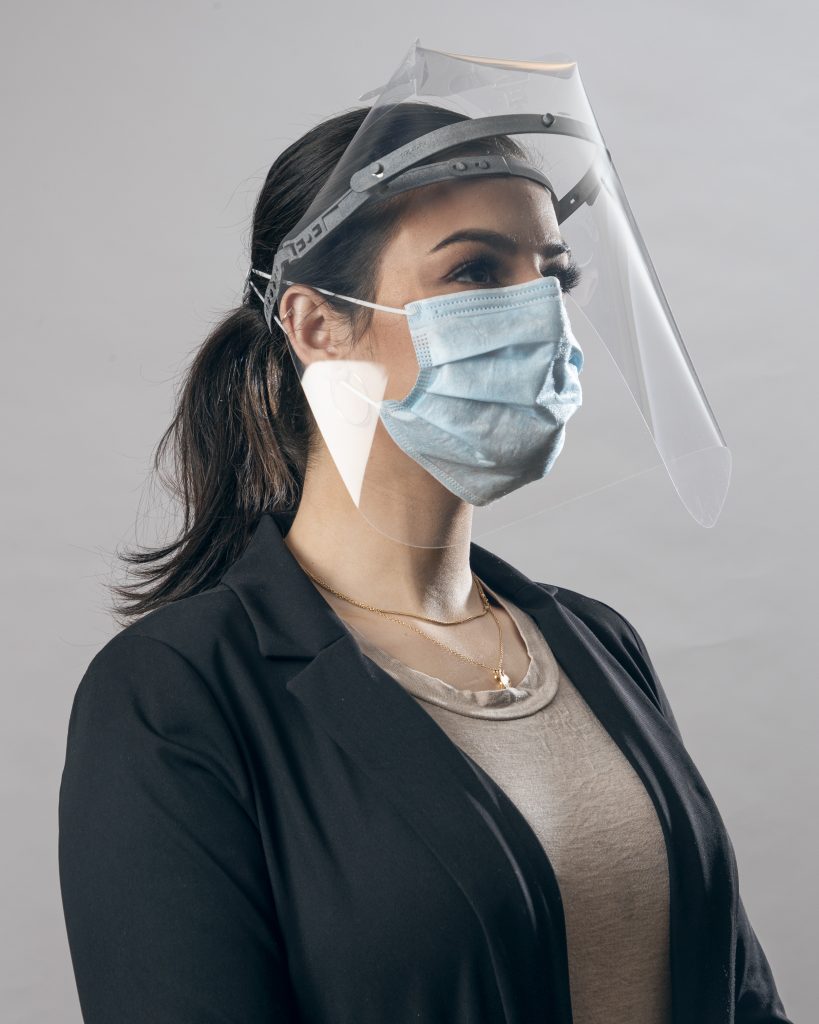
Features
3D Printing
COVID-19
Printing
Joining the fight against COVID-19
HP Canada partners with federal government to 3D print face shields for frontline workers
October 16, 2020 By Kavita Sabharwal-Chomiuk
 Photo: HP Canada
Photo: HP Canada As the coronavirus pandemic continues to impact lives around the globe, personal protective equipment (PPE) remains vital to guard frontline workers against the spread of COVID-19.
In an effort to help ease the PPE shortage, in May, HP Canada announced it had formed a partnership with the federal government to supply 540,000 3D printed face shields to frontline healthcare workers. According to HP Canada, “this partnership marks the largest coordinated effort to establish a domestic supply chain for critical PPE at this scale.”
In order to fulfill the order, HP Canada enlisted nine members of its digital manufacturing partner network that specialize in 3D printing technology to mobilize their teams, technology, experience and production capacity to manufacture face shields for Canada’s frontline workers. The nine partner businesses are spread across Ontario, British Columbia, Manitoba, Quebec and Alberta, and include Leo Lab, EXO-S and Proto3000. The shields began shipping out soon after the partnership was announced in May.
According to Mary Ann Yule, president and CEO at HP Canada, HP decided early in the pandemic to enlist its 3D printing team and digital manufacturing community with designing, validating and producing essential parts for medical responders and hospitals. In March, HP also announced that it was making 3D design files available for free to accelerate production of critical parts, including PPE.
“We knew we could step in with a 3D printed solution manufactured in Canada to help fulfill the urgent need for PPE, but couldn’t do it alone,” says Yule. “Thanks to the strength of our digital manufacturing community, we leaned on small and medium sized businesses across the country to quickly pivot their supply chain and outputs to focus on PPE.”
Reuben Menezes is marketing manager at Proto3000, a member of HP’s digital manufacturing partner network. According to him, as one of Canada’s largest 3D printing companies, Proto3000 knew that it would be going to work to help supply critical PPE amid the shortage experienced when the pandemic hit.
“We worked on getting our Health Canada approval to manufacture class 1 medical devices, and in tandem, the HP team quickly validated different designs and applications that could be 3D printed and once a final design was settled on for the face shield, as an HP production partner, we got to work on making them,” says Menezes.
The HP MultiJet Fusion 3D printing technology is used to create the headpiece of the face shield. Proto3000 has been using its HP MultiJet Fusion 3D printing technology in its ISO 9001:2015 service bureau for nearly two years, so it was a natural next step to start quickly creating PPE due to the printer’s speed, throughput and ability to 3D print with biocompatible materials.
“It is a binder jetting style of 3D printing that layers powdered PA 12 Nylon material, combines it with fusion agents and heats it to produce a very strong part,” says Menezes.
Menezes says a single printer can produce approximately 275 shields over an 11-to-16-hour period, however he notes that Proto3000 has multiple systems. At full capacity, Proto3000 can manufacture 1,500 to 2,000 face shields per day.
He adds that Proto3000 doubled its 3D printers to make sure the company would be able to produce the face shields as quickly as possible. The shields are being delivered to the Government of Canada, which is handling the logistics of where to distribute the critical PPE.
The shields have been approved for use by frontline workers by Health Canada. The process to get the shields approved was not a lengthy one, as the necessity for PPE was strong enough that the request was rushed by the federal government.
“HP Canada brought together industry experts and our digital manufacturing community to form a council which allowed us to respond quickly to the urgent need for PPE,” says Yule. “The Canadian federal government then expedited the process by moving to ensure COVID applications for licensing were processed quickly. I like to say we went from a dream and powder to face shields protecting Canadians in less than one month.”
According to Yule, the pandemic has led to a watershed moment for the 3D printing industry, as its benefits – speed, flexibility, sustainability and design capabilities – have allowed manufacturers to shift gears quickly amid the pandemic.
“Now, companies are developing new supply chain strategies for risk mitigation to address future pandemics and guard against volatile global economic trade cycles. Advanced 3D printing solutions can help organizations accelerate these strategies and will continue to shape the manufacturing landscape in Canada,” she says. “Increasingly, more companies are looking to transform their manufacturing capabilities, not only to remain competitive but to strengthen their response to demand for products made in Canada. It is fantastic to see local businesses joining forces to reinvent manufacturing in Canada. We are extremely proud to be able to support the healthcare industry during these unprecedented times.”
Menezes adds that the team at Proto3000 is happy to play its part in supporting the country amid the pandemic.
“We see all that our healthcare workers and essential staff are doing to keep us safe and keep the country moving, and we are honoured to be able to support them in any way we can,” he says.
Print this page
